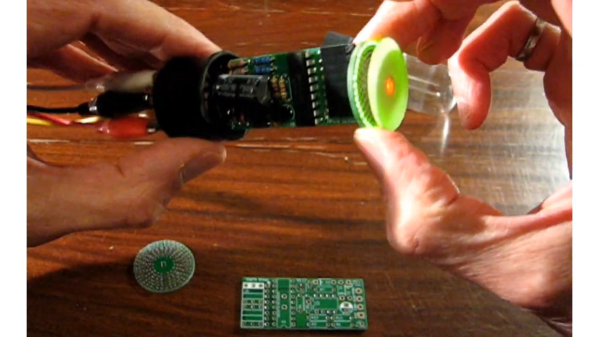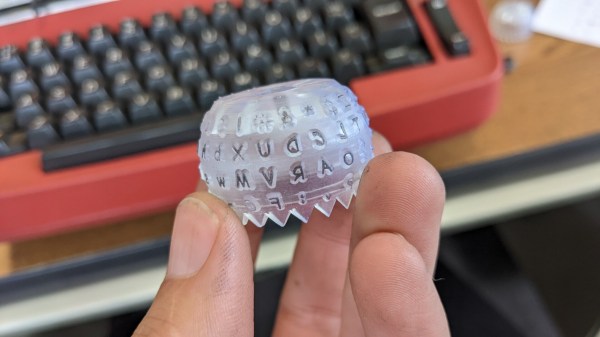The classic “Magic Eye” tuning indicator was a fantastic piece of vacuum tube technology that graced all kinds of electronic gear for a fair fraction of the 20th century. But despite its prevalence, finding a new-old-stock Magic Eye tube is a tall order these days, especially for the rare versions like the 6T5. No worries, though, since direct plug-in solid-state replacements for the 6T5 are now a thing, thanks to [Gord Rabjohn]. Continue reading “The Eyes Have It With This Solid State Magic Eye”
classic hacks2792 Articles
IBM Selectric Typewriters Finally Get DIY Typeballs
IBM’s Selectric line of typewriters were quite popular in the 1960s, thanks in part to an innovation called the typeball which allowed for easy font changes on a single machine. Unfortunately, as if often the case when specialized components are involved, it’s an idea that hasn’t aged particularly well. The Selectric typewriters are now around 60 years old and since IBM isn’t making replacement parts, those restoring these machines have had to get somewhat creative like using a 3D printer to build new typeballs.
 It sounds like it would be a simple, but much like the frustration caused with modern printers, interfacing automated computer systems with real-world objects like paper and ink is not often as straightforward as we would like. The main problem is getting sharp edges on the printed characters which is easy enough with metal but takes some more finesse with a printed plastic surface. For the print, each character is modelled in OpenSCAD and then an automated process generates the 3D support structure that connects the character to the typeball.
It sounds like it would be a simple, but much like the frustration caused with modern printers, interfacing automated computer systems with real-world objects like paper and ink is not often as straightforward as we would like. The main problem is getting sharp edges on the printed characters which is easy enough with metal but takes some more finesse with a printed plastic surface. For the print, each character is modelled in OpenSCAD and then an automated process generates the 3D support structure that connects the character to the typeball.
This process was easier for certain characters but got more complicated for characters with interior sections or which had a lot of sharp angles and corners. Testing the new part shows promise, although the plastic components will likely not last as long as their metal counterparts. Still, it’s better than nothing.
Regular Hackaday readers may recall that the ability to 3D print replacement Selectric typeballs has been on the community’s mind for years. When we last covered the concept in 2020 we reasoned that producing them on resin printers might be a viable option, and in the end, that does indeed seem to have been the missing element. In fact, this design is based on that same one we covered previously — it’s just taken this long for desktop resin 3D printing technology to mature enough.
Mechanical GIF Animates With The Power Of Magnets
It doesn’t matter how you pronounce it, because whichever way you choose to say “GIF” is guaranteed to cheese off about half the people listening. Such is the state of our polarized world, we suppose, but there’s one thing we all can agree on — that a mechanical GIF is a pretty cool thing.
What’s even better about this thing is that [Mitch], aka [Hack Modular], put some very interesting old aircraft hardware to use to make it. He came upon a set of cockpit indicators from a Cold War-era RAF airplane — sorry, “aeroplane” — that used a magnetically driven rack and pinion to swivel a set of prism-shaped pieces to one of three positions. Which of the three symbols displayed depended on which faces were turned toward the pilot; they were highly visible displays that were also satisfyingly clicky.
After a teardown in which [Mitch] briefly discusses the mechanism behind these displays, he set about customizing the graphics. Rather than the boring RAF defaults, he chose three frames from the famous Horse in Motion proto-motion picture by [Eadweard Muybridge]. After attaching vertical strips from each frame to the three sides of each prism, [Mitch] came up with a driver for the display; he could have used a 555, but more fittingly chose series-connected relays to do the job. Capacitors slow down the switching cascade and the frame rate; a rotary switch selects different caps to make the horse appear to be walking, trotting, cantering, or galloping — yes, we know they’re each physically distinct motions, but work with us here.
The whole thing looks — and sounds — great mounted in a nice plastic enclosure. The video below shows it in action, and we find it pretty amazing the amount of information that can be conveyed with just three frames. And we’re surprised we’ve never seen these displays before; they seem like something [Fran Blanche] or [Curious Marc] would love.
Continue reading “Mechanical GIF Animates With The Power Of Magnets”
Tube Amplifier Uses Low Voltage, Sips Battery
Much like vinyl records, tube amplifiers are still prized for their perceived sound qualities, even though both technologies have been largely replaced otherwise. The major drawback to designing around vacuum tubes, if you can find them at all, is often driving them with the large voltages they often require to heat them to the proper temperatures. There are a small handful of old tubes that need an impressively low voltage to work, though, and [J.G.] has put a few of them to work in this battery-powered audio tube amplifier.
The key to the build is the Russian-made 2SH27L battery tubes which are originally designed in Germany for high-frequency applications but can be made to work for audio amplification in a pinch. The power amplifier section also makes use of 2P29L tubes, which have similar characteristics as far as power draw is concerned. Normally, vacuum tubes rely on a resistive heater to eject electrons from a conductive surface, which can involve large amounts of power, but both of these types of tubes are designed to achieve this effect with only 2.2 volts provided to the heaters.
[J.G.] is powering this amplifier with a battery outputting 5V via a USB connection, and driving a fairly standard set of speakers borrowed from a computer. While there aren’t any audio files for us to hear, it certainly looks impressive. And, as it is getting harder and harder to find vacuum tubes nowadays, if you’re determined to build your own amplifier anyway take a look at this one which uses vacuum tubes built from scratch.
Typewriter Mashup Becomes 120-Year-Old Teletype
Vintage typewriters can be beautiful and elegant devices. But there’s a limit to their value if, as with the 1903 Remington owned by [Daniel Ross], they are fire-damaged and have a seized mechanism. What did he do with what was essentially a piece of scrap metal? Produce an unholy mashup of the vintage machine and a 1988 Sharp daisy wheel typewriter to make a steampunk-style teletype, of course!
Stripping down both machines was evidently no easy task, and the result he’s achieved has the Sharp’s printer mechanism at 90 degrees to its original orientation sitting below the roller in the space once occupied by the Remington’s type bars. We’re sad to see that the keyboard on the older machine appears to be inoperable, but on the other hand each letter does light up as it’s typed.
Meanwhile at the electronics side the components from the Sharp have been transferred to a custom PCB, and the whole can be driven from a 300-baud serial line. As can be seen from the video below the break, the result is an unholy love-child of two typewriters that could scarcely be more different, but somehow it works to make an impressive whole.
If this project looks a little familiar to Hackaday readers, it’s because we’ve mentioned it in passing before. It’s hooked up to his COSMAC Elf retrocomputer, and we saw it in passing a couple of years ago at a much earlier stage of construction before the custom PCB and light-up keyboard.
Continue reading “Typewriter Mashup Becomes 120-Year-Old Teletype”
Generating Instead Of Storing Meshes
The 64kB is a category in the demoscene where the total executable size must be less than 65,536 bytes, and at that size, storing vertexes, edges, and normal maps is a waste of space. [Ctrl-Alt-Test] is a French Demoscene group that has been doing incredible animations for the last 13 years. They’ve written an excellent guide on how they’ve been procedurally generating the meshes in their demos.
It all starts with cubes. By stacking them, overlaying them, reusing them, and tiling them you can get better compression than raw vertexes. Revolution was the next trick, as it uses just a few points, plotting it via Catmul-Rom splines, and revolving around an axis. The numbers are pairs of 32-bit floats and before compression, a detailed pawn on a chess board can weigh in at just 40 bytes. Just these few techniques can take you surprisingly far (as seen in the picture above).
They later worked on deforming cubes and placing them into a semi-randomized column, which happened to look a lot like plants. This isn’t the first generated vegetation we’ve seen, and the demoscene technique focused more on getting the shape and setting the mood rather than being accurate.
Signed distance fields are another useful trick that allows you to generate a mesh by implementing a signed distance function and then running a marching cubes algorithm on it. In a nutshell, a signed distance function just returns the distance to the closest point on a surface from a given point. This means you can describe shapes with just a single mathematical equation. As you can imagine, this is a popular technique in the demoscene world because it is so space efficient in terms of code and data. [Ctrl-Alt-Test] even has a deep dive into one of their projects, Immersion, with a breakdown of where the space is allocated.
There are plenty of other tips and tricks here, such as generating textures and developing a C++ hot reload system for faster iteration. It’s just incredible that the executable that plays the whole video is smaller than just a JPEG screenshot of the video. It’s a reminder that the demoscene is still fascinating with new tricks and experiences even as the hardware stays the same. Continue reading “Generating Instead Of Storing Meshes”
Two-Tube Spy Transmitter Fits In The Palm Of Your Hand
It’s been a long time since vacuum tubes were cutting-edge technology, but that doesn’t mean they don’t show up around here once in a while. And when they do, we like to feature them, because there’s still something charming, nay, romantic about a circuit built around hot glass and metal. To wit, we present this compact two-tube “spy radio” transmitter.
From the look around his shack — which we love, by the way — [Helge Fykse (LA6NCA)] really has a thing for old technology. The typewriter, the rotary phones, the boat-anchor receiver — they all contribute to the retro feel of the space, as well as the circuit he’s working on. The transmitter’s design is about as simple as can be: one tube serves as a crystal-controlled oscillator, while the other tube acts as a power amplifier to boost the output. The tiny transmitter is built into a small metal box, which is stuffed with the resistors, capacitors, and homebrew inductors needed to complete the circuit. Almost every component used has a vintage look; we especially love those color-coded mica caps. Aside from PCB backplane, the only real nod to modernity in the build is the use of 3D printed forms for the coils.
But does it work? Of course it does! The video below shows [Helge] making a contact on the 80-meter band over a distance of 200 or so kilometers with just over a watt of power. The whole project is an excellent demonstration of just how simple radio communications can be, as well as how continuous wave (CW) modulation really optimizes QRP setups like this.
Continue reading “Two-Tube Spy Transmitter Fits In The Palm Of Your Hand”

















